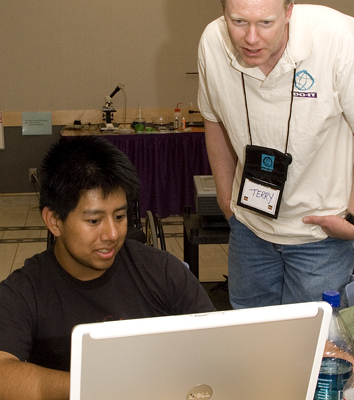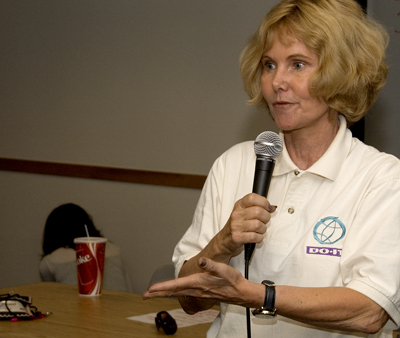Systemic Change
Research Questions
- What do we know about systemic change that can guide the design and implementation of professional development for faculty and administrators regarding the equal access for students with disabilities in their courses and programs?
- What do we know about sustaining faculty and administrator development activities for supporting students with disabilities?
Overview of Research
It has been said that you cannot change one thing without changing the whole thing (Price Waterhouse Change Integration Team, 1995). If you redesign processes or change requirements on a college campus, you can expect that you will also need to change job descriptions, systems, and technologies and then train people to support them.
The participation of students with diverse abilities and disabilities in colleges and universities has inspired institutions to change some of their traditional structures and procedures. Postsecondary institutional experiences in promoting diversity related to gender, ethnicity, race, and socioeconomic status have taught us that change does not occur quickly or without conflict. Creating a more inclusive environment for students with disabilities often requires system-wide, sustainable change. Successful change efforts are more often gradual than radical.
Although there is typically resistance to change, change is central to college and university cultures (Andresen, 1991). New laws, demographics, technologies, and educational theories and goals are part of their realities (Englert & Tarrant, 1995).
Competing theories about systemic change abound. However, success in implementing change is often more related to a specific context than to a general theory (Wilson, 1992)."The argument has been largely against skill-based approaches, ready-made models of good organizational practice, and reliance upon analyzing change as primarily the outcome-oriented pursuit of great and charismatic individuals. The arguments have, rather, favored the potency of organizational structures, of economic determinism, and of institutionalization within which the manager must operate" (Wilson, 1992, p. 122).
Change can be viewed from three perspectives: the reason for change, the process of change, and the content of change (Levy & Merry, 1986). First we will consider the reasons for change and then the process of change.
External and Internal Forces
Postsecondary institutions experience pressure to change from both external and internal sources (Yee & Los Angeles ERIC Clearinghouse for Community Colleges, 1998). As change in the external environment accelerates, institutions must respond to these changes in order to thrive (Kozeracki, 1998). For example, one of the external factors promoting change is the worldwide transformation of the economy from a production-based system to a knowledge- and information-based system. The development of new technologies has caused faculty to re-examine the content and delivery of instruction (Travis, 1995). The incorporation of new computer electronic and information technologies over recent years provides an example of how rapidly new products and behaviors can be assimilated into campus life. Not long ago, cell phones, fax machines, and email were considered futuristic. Today they are a part of everyday life.
Technology creates opportunities for students with disabilities to access education in innovative ways. For example, students who are blind and use speech output systems can participate in online education courses as long as these courses are designed so that they are accessible. Online courses may also provide access to students who cannot take courses because of schedule conflicts or geographic location.

Terry O'Banion (1997), president emeritus and senior fellow of the League for Innovation in the Community College, proposed that an improved"learning college" may build its foundation on technology because technology is"ism-free" (e.g., racism, sexism, ageism). Some faculty members welcome these changes; some resist. Nevertheless, technology plays a significant role in systemic change.
Legislative and funding issues can also force institutions to change. For example, Section 504 of the Rehabilitation Act, the ADA, and state legislation require that institutions provide reasonable accommodations for qualified students with disabilities in programs and services. Due in part to such legislation, increasing numbers of students with disabilities are gaining access to programs, placing further pressure on institutions to become more inclusive.
Differences in the economy, government relations, and the demographics of the student body (e.g., more immigrants, high school dropouts, returning and displaced workers, welfare participants, and workers in need of skill upgrading) require responses from postsecondary institutions (Levin, 1998). Today's student body is diverse with respect to age, gender, ethnic and racial background, disability, and part-time student status (Yee & Los Angeles ERIC Clearinghouse for Community Colleges, 1998). Changing populations call for increased multicultural awareness (Harris & Kayes, 1995; Rend—n & Hope, 1996). Stereotyping, social isolation, and alienation are experienced by women, students with disabilities, and adult learners as well as by students of ethnic diversity (Smith, 1989). Over 11% of people in postsecondary programs have an identified disability (U.S. Department of Education, 2006). The cumulative result is a demand for institutions to create more inclusive learning environments that are socially and culturally responsive. The way"tech-prep" and school-to-work movements have stimulated faculty to collaborate with high school staff and to incorporate more career-related skill-building into the curricula provides an example of how systemic change can occur as a result of external forces (Latham, 1995).
Forces internal to the institution can also promote or inhibit change. Academic values and attitudes about diversity can motivate faculty members and administrators to advocate for educational equity. Seeing students with disabilities as a minority group with civil rights to education instead of as a needy population deserving of charity has dramatically changed the service provision for students with disabilities in recent years (Oliver & Barnes, 1998; Shapiro, 1993). Diverse perspectives within organizations promotes sensitivity to pluralism.
Process of Change
A growing body of research reflects the importance of student involvement in an institution's change process. Over an extended period of time, students can help identify and prioritize problems and suggest potential solutions.
Frank and Rocks' (1996) model for effective transition and change involves conceptualization of the change parts, active reflection, and commitment. It requires engagement of leadership personnel and management of the systems undergoing change.
Institutions that are successful in integrating diverse groups of students tend to:
- focus on student success and provide tools for success
- enhance coordination and articulation with other educational levels
- dedicate resources to fostering acceptance
- have access to good information on the institution and students
- have leaders in the faculty and administration who provide direction for these efforts
Some postsecondary educators have responded to student diversity by modifying the organizational culture, infusing multicultural education into the curriculum, reflecting a diversity in values and norms in organizational policies and practices, and creating campus-wide action committees (Guy, Reiff, & Oliver, 1998; Harris & Kayes, 1995; Levy & Merry, 1986).
However, a fundamental and continuing conflict exists between diversity and quality in postsecondary education. Faculty may need to reform their understanding of academic quality and then modify standards, performance criteria, and assessment tools (Smith, 1989). Infusing multicultural education at an organizational level requires simultaneous changes in the organization's values and culture (Guy, et al., 1998). Strategies include the following:
- Build a powerful case for change. Assume that people are not prepared for change and convince them, using consensus building and education, that change is both appropriate and needed. Practical and immediate action steps are most helpful to share in training sessions.
- Let the customer drive change. In postsecondary institutions, customers include both the students with disabilities attending programs and the faculty and staff delivering and supporting them.
Keep in mind that faculty members may be more open to new ideas when they are actively involved in the process (Kuveke, 1996). College faculty and staff at one school, which had clear and open communication as the basis of its change process, effectively implemented change."Inherent was a mutual respect for the other's background and talents, plus a genuine perception of their equality" (Hord, 1986, p. 22).
Faculty and administrators can benefit from keeping four questions in mind when starting change efforts (Bruce & Wyman, 1998):
- Who are the people involved in the change?
- What are the organization's abilities and resources?
- What is the climate for change?
- What are the mandates/objectives of the organization?
In order for systemic change to take place, there must be adequate motivation from the institution as well as a supportive social and cultural climate. Although faculty may be motivated to learn new skills and knowledge that will enhance student learning, a competing motivation may be to maintain their existing standards and methods of teaching. They need practical examples of the benefits of change. Sometimes it is effective to apply the power of peer example by sharing the experiences of other faculty (Svinicki, 1996).
Supporting the process of change involves providing student and staff development opportunities and ensuring that policies support access to all postsecondary education programs and coursework for all qualified students. The content of professional development should include examples of academic accommodations for students with disabilities, legal issues, and campus resources. Emphasis should be placed on the importance of student involvement in the process and the relationship between the student and his or her instructors (Levy & Merry, 1986).
Change efforts should be multi-dimensional and system-wide. Transformation of the institution into a system that supports diversity means addressing a number of issues including faculty and staff diversity; institutional mission and values; diversity education; the quality of interaction between students, faculty, and the administration; and the perceived conflict between quality and diversity (Townsend & Twombly, 1998). Institutional changes should be reflected in policies, procedures, and job assignments to ensure that if one person leaves a position, the program of change will not collapse.
Promoters and Inhibitors of Change
Specific conditions on a postsecondary campus can serve to promote or inhibit change toward a more inclusive environment for students with disabilities. Factors include those related to:
- legislation
- awareness
- attitudes
- diversity efforts
- change
- cost
- market forces (Burgstahler, 2008a)
General project management principles can be applied in systematically employing practices to increase the academic success of students with disabilities (Jenner, 2008). Collaborative relationships among all stakeholder groups are keys to success (Finn, Getzel, Asselin, & Reilly, 2008). Besides the institution itself, industry, professional organizations, researchers, consumers, and government can each play a role in promoting UD on a college or university campus. The ultimate goal is to make educational offerings welcoming, accessible, and usable for all students.
Implications for Practice
To make improvements in teaching students with disabilities on a postsecondary campus, provide faculty and administrator professional development, ensure that students are aware of resources, and develop adequate systems for students with disabilities and staff to access resources. The content of professional development should include information about accommodations, rights and responsibilities, and campus resources.

When implementing systemic change, make efforts to consider the capabilities and limits of the institution and educators. Encourage gradual, sustained changes that involve all parties and resources in the change process. For instance, annual departmental mini-inservices, new faculty and TA orientations, and mailings regarding universal design of instruction and accommodations for students with disabilities will support systemic change moreso than a large, one-time event.
Give students and faculty members an active role in designing and implementing changes, since they have vested interests in the outcomes. Encourage reflective and solution-oriented communication. Solicit collaborative input from all stakeholders regarding materials, decisions, and publicity. Lasting improvements are more likely to occur when those who have a stake in the change are instrumental in making the changes.
Conclusion
In postsecondary institutions, long-lasting positive changes require systemic (institutional) change rather than isolated actions of individuals. Collaborative efforts of faculty, administrators, staff, and students should work toward the goal of educational equity.